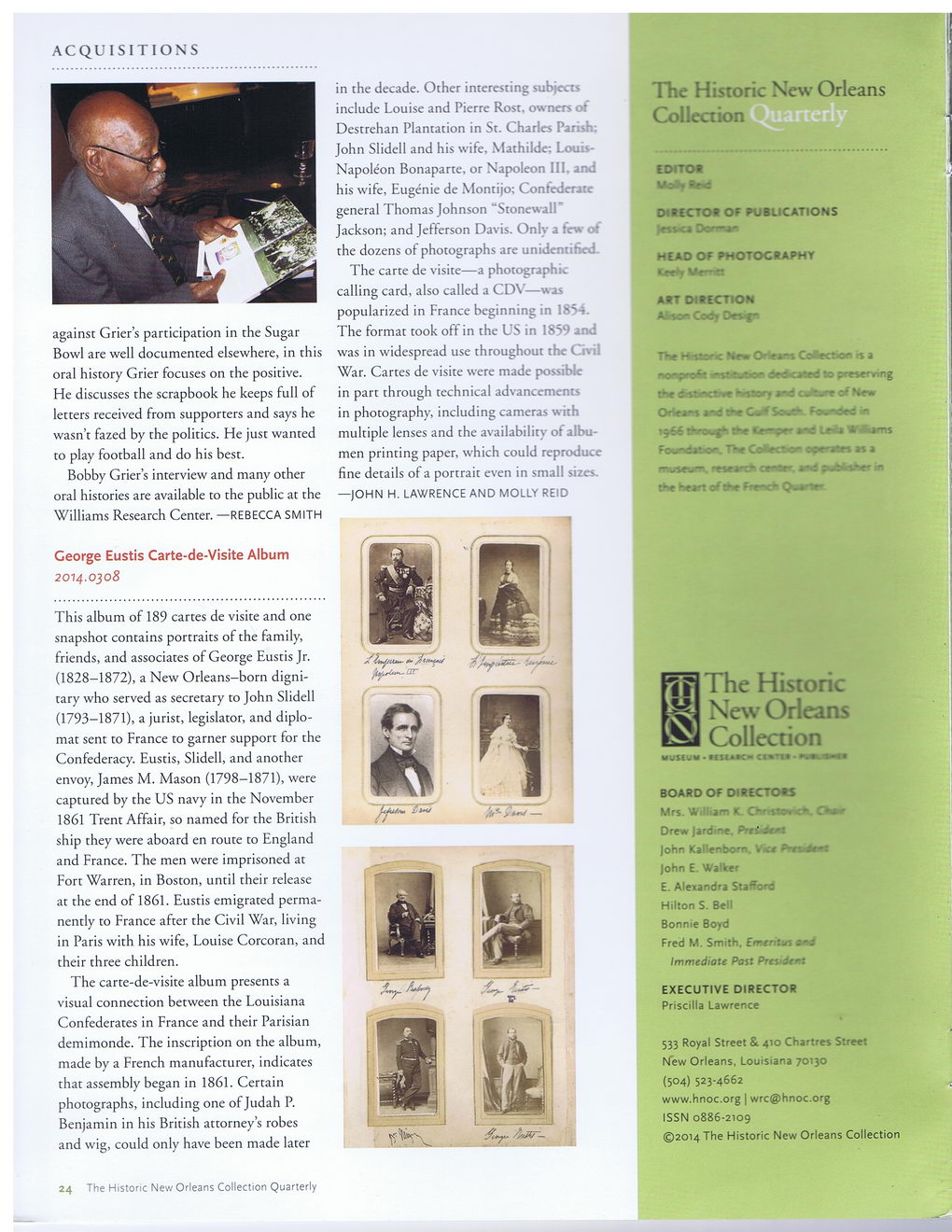This text was obtained via automated optical character recognition.
It has not been edited and may therefore contain several errors.
ACQUISITIONS against Grier’s participation in the Sugar Bowl are well documented elsewhere, in this oral history Grier focuses on the positive. He discusses the scrapbook he keeps full of letters received from supporters and says he wasn’t fazed by the politics. He just wanted to play football and do his best. Bobby Grier’s interview and many other oral histories are available to the public at the Williams Research Center. —REBECCA SMITH George Eustis Carte-de-Visite Album 2014.0308 This album of 189 cartes de visite and one snapshot contains portraits of the family, friends, and associates of George Eustis Jr. (1828-1872), a New Orleans-born dignitary who served as secretary to John Slidell (1793-1871), a jurist, legislator, and diplomat sent to France to garner support for the Confederacy. Eustis, Slidell, and another envoy, James M. Mason (1798-1871), were captured by the US navy in the November 1861 Trent Affair, so named for the British ship they were aboard en route to England and France. The men were imprisoned at Fort Warren, in Boston, until their release at the end of 1861. Eustis emigrated permanently to France after the Civil War, living in Paris with his wife, Louise Corcoran, and their three children. The carte-de-visite album presents a visual connection between the Louisiana Confederates in France and their Parisian demimonde. The inscription on the album, made by a French manufacturer, indicates that assembly began in 1861. Certain photographs, including one of Judah P. Benjamin in his British attorney’s robes and wig, could only have been made later in the decade. Other interesting subjcc-:-include Louise and Pierre Rost, owners <»t Destrehan Plantation in St. Charles Pari?1, John Slidell and his wife, Mathilde; Louts-Napoleon Bonaparte, or Napoleon III, and his wife, Eugenie de Montijo; Confederate general Thomas Johnson “Stonewall” Jackson; and Jefferson Davis. Only a fin of the dozens of photographs are umdontif-^-.' The carte de visite—a photographic calling card, also called a CDV—was popularized in France beginning in 185-1. The format took off in the US in 1859 ana was in widespread use throughout the Ci*:_ War. Cartes de visite were made possible in part through technical advancement' in photography, including cameras with multiple lenses and the availability of albumen printing paper, which could reproduce fine details of a portrait even in small sizes. —JOHN H. LAWRENCE AND MOLLY REID Nsw Orleans irioNs HT3TO Qf. P*4©l5©*fiA£H'!f 6te^?H9wee MSS H35S53QS Ite C iMc Mser Oriaaan Oafcrswd t: s ulilrra ij w ^66 6Bd late fiSfer iliiSBlBeew «e*tes fle a rr~ At ‘ — If] I he Historic 1 NcwOrkans Collection \J - pNSSlifcdftjKi £ * ' jLr &XT- BOARD OF IX it it POSES V'*. Willi.'iffi it Drew Jarrfi'..:. John r’^'l 'V,V, John E. \»3ibsf E. Alexandra Hilton S. Beil Bonnie Boyd Fred M. SmitK im Immediate Pan President EXECUTIVE DIRECTOR Priscilla Lawrence 533 Royal Street & 410 Chartres Street New Orleans, Louisiana 70130 (504) 523-4662 www.hnoc.org | wrc@hnoc.org ISSN 0886-2109 ©2014 The Historic New Orleans Collection 24 The Historic New Orleans Collection Quarterly

New Orleans Quarterly 2015 Winter (26)
